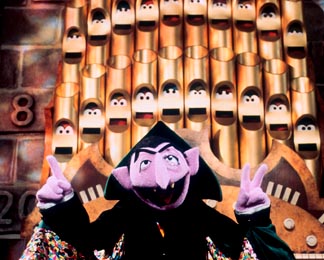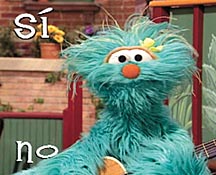Reopening the Street Originally published in Current,
Nov. 19, 2001 Pssst! Here's the word from television's most famous street: there are changes--big changes--ahead for the show that's introduced generations of youngsters to letters and numbers, ethnic diversity and cute monsters. Sesame Street, begun in 1968 as an experiment in preparing underprivileged children for school, is adapting to new realities of the kid-media landscape--acknowledging that some research-based premises of the show's original design are no longer valid. The pioneering magazine format--with its intertwining story line, interrupted by short elements on a letter or number of the day, Muppet antics and live-action bits of children's lives--is being recast into a more predictable, modular format. A pared-back corps of popular Muppet characters will star in their own segments, and the story from the streetscape will be consolidated into a single piece 8-10 minutes long. "Journey to Ernie," a new element that simulates the feel of a CD-ROM, calls on viewers to help Big Bird think through puzzles in a hide-and-seek game with Ernie. Producers at Sesame Workshop devised the new format after conducting an extended "think tank" on how to make the show more appealing to an audience that's getting younger. They consulted with parents, competing producers, educators, kids TV researchers and public TV execs. "We have been blessed with longevity, but with that comes responsibility to make sure that you are current with the needs of children," explains Lewis Bernstein, v.p. of global Sesame Street production. "We are the only preschool show that's an hour long, and we wanted to make sure we were engaging this younger audience and teaching them what we were purporting to teach them," says Michael Loman, executive producer. Sesame Workshop--the Manhattan production house formerly known as Children's Television Workshop--has always used research to make creative decisions about the show and its curriculum, but changes in technology and viewing habits required that producers completely re-examine fundamental principles of the series. One of these, based on research by Swiss child psychologist Jean Piaget, was the belief that young children have short attention spans and can't follow extended story lines. Inspired by this insight, and the rapid-fire cleverness of 1960s advertising and sketch comedy, the series creators combined "bits that didn't relate to each other, interrupted by letter and number commercials," recalls Bernstein. But preschoolers today are watching story-driven movies, videos and TV shows. "Kids enjoy stories and they want to see them beginning to end," says Rosemarie Truglio, v.p. of research. "We were making it harder on them with all the interruptions." "When we've done research on children watching Sesame Street, we found that the segment boundaries end up being the times when kids stop watching," comments Dan Anderson, a children's TV researcher at the University of Massachusetts in Amherst. He was among the outside experts who advocated a modular, predictable design. "They were probably feeling some sense of crisis because the show has a lot more competition now than it had when it got started, and a lot of the shows they're competing with are of fairly high quality, both in entertainment for preschoolers but also in terms of curriculum." Sesame Street's audiences have contracted substantially as media offerings for preschoolers expanded in the mid-1990s--from a 2.0 average on Nielsen's people meters in 1995-96 to a 1.3 average in 2000-01, according to PBS Research. Some of the competition comes from other programs in the PBS Kids line-up. As the network added new children's series, stations cut back on telecasts of older shows--Barney & Friends and Mister Rogers' Neighborhood as well as Sesame Street. Still, on an average week, more than 5.6 million households tune into Sesame Street and 7.5 million people aged 2 and older watch. Among all children's shows on television, the Street ranks eight on the list of the most watched. For mothers aged 18-49 with children under 3--the most coveted demographic in TV--Sesame Street is the second-most-watched kids' show. That's "a powerful position in terms of ratings," says Pat Nugent, senior director of children's programming for PBS. "They're still doing really well. It's something to be celebrated." Energized by ElmoYears ago, the target audience for Sesame Street was 4-year-olds, but lately the series has attracted younger viewers. The addition of "Elmo's World," a 15-minute daily segment introduced in 1998, accelerated this shift. Response to it has been tremendous, says Truglio. "Elmo's World" was tailored to interest 3-year-olds, but even babies can find it appealing. It operates like a show within Sesame Street with it's own introductory "la-la, la-la" song. Each installment is based on a theme, like books, and combines silliness, learning and interaction with the most irresistible 3-year-old on the street. Producers placed "Elmo's World" at the end of each episode because they knew they were losing viewers 45 minutes into Sesame Street. It did more than just hold onto tykes--it energized them. "When it comes on at the 45-minute mark, children get excited and sing the opening song and call out," explains Truglio. The response created momentum to re-think the main body of Sesame Street. The Tipping Point, Malcolm Gladwell's influential book about social epidemics, profiled the research-based process through which Sesame Street was created in the late 1960s, and contrasted it with the design of Blue's Clues, the Nickelodeon hit. Gladwell concluded that creators of Blue's Clues crafted a show that, because of its simplicity, interactive elements and predictability, had a quality called "stickiness" that Sesame Street lacked. "We all read that," says Bernstein. Gladwell detailed the empirical approach that the workshop takes to production design, but he didn't describe the effects of Sesame Street's longevity, he comments. "When you're 33 years old, you have a lot of stuff that accumulates on the set and behind the set." In making improvements over the years, the show had expanded until it became unwieldy for its younger viewers. The set had grown, and the show routinely added new puppets and actors. "There was too much of everything," says Loman. "We decided to simplify the show and focus on a core number of characters, and we went back to the original-size set." The aim is to let children get to know major characters and a simpler street. Several popular puppets--the Count, Cookie Monster, Big Bird and Ernie--have their own segments. A trio of Rosita, Zoe and a new lavender monster named Lulu will have girlie fun together. Zoe even gets a ballerina's tutu that she "loves to wear all the time," says Loman. "This gives her license to be constantly pirouetting in the air." The creative team struggled with the problem of meeting the needs of a younger audience without losing the "edge, sophistication, humor and challenge" that defines Sesame Street, Loman adds. "It's a challenging show; it's not like putting them in front of a cartoon for an hour. We are really making them work." The curriculum remains broad-based with cognitive, academic, social/emotional and physical education goals, says Truglio. A daily segment on the Spanish word of the day will foster bilingual skills. Preschoolers should be able to navigate the full hour more easily as the modules become familiar to them. Adult humor and celebrity appearances--which have always encouraged parents to watch Sesame Street with their kids--are written into each show, but "never at the expense" of a child's understanding, says Truglio. "Even if it's nothing other than the vocabulary that we use," adds Loman, "everybody felt that was a very important part of the show." |
|
||




